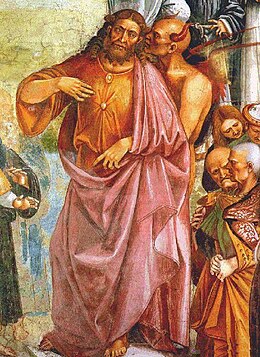
Back Antichris Afrikaans عدو المسيح Arabic المسيح الدجال ARZ Антыхрыст Byelorussian Антыхрыст BE-X-OLD Антихрист Bulgarian খ্রিষ্টারি Bengali/Bangla Antikrist BS Anticrist Catalan Antikrist Czech


In Christian eschatology, the Antichrist refers to people prophesied by the Bible to oppose Jesus Christ and substitute themselves as "saviors" in Christ's place before the Second Coming.[1] The term Antichrist (including one plural form)[2] is found four times in the New Testament, solely in the First and Second Epistle of John.[2] The Antichrist is announced as the one "who denies the Father and the Son."[2]
The similar term pseudokhristos or "false Christ" is also found in the Gospels.[3] In Matthew (chapter 24) and Mark (chapter 13), Jesus alerts his disciples not to be deceived by the false prophets, who will claim themselves to be the Christ, performing "great signs and wonders".[4][5][6] Three other images often associated with the Antichrist are the "little horn" in Daniel's final vision, the "man of sin" in Paul the Apostle's Second Epistle to the Thessalonians, and the Beast of the Sea in the Book of Revelation.[7][8][9]
- ^ Lietaert Peerbolte, Bert Jan (2018). "Antichrist". In Hunter, David G.; van Geest, Paul J. J.; Lietaert Peerbolte, Bert Jan (eds.). Brill Encyclopedia of Early Christianity Online. Leiden, Netherlands and Boston, Massachusetts: Brill Publishers. doi:10.1163/2589-7993_EECO_SIM_00000194. ISSN 2589-7993. S2CID 239226039.
- ^ a b c 1 John 2:18–22; 4:1–6. 2 John 1:7–11.
- ^ Strong, James (1890). "G5580 – pseudochristos". Strong's Concordance. Blue Letter Bible. Retrieved 27 December 2021.
ψευδόχριστος pseudóchristos, psyoo-dokh'-ris-tos; [...] a spurious Messiah:—false Christ. ψευδόχριστος, ψευδοχριστου, ὁ (ψευδής and χριστός), a false Christ (or Messiah) (one who falsely lays claim to the name and office of the Messiah): Matthew 24:24; Mark 13:22.
- ^ Aune, David E. (1983). "The Prophecies of Jesus: Unmasking False Prophets". Prophecy in Early Christianity and the Ancient Mediterranean World. Grand Rapids, Michigan: Wm. B. Eerdmans. pp. 222–229. ISBN 978-0-8028-0635-2. OCLC 9555379.
- ^ Chae, Young S. (2006). "Matthew 7:15: False Prophets in Sheep's Clothing". Jesus as the Eschatological Davidic Shepherd: Studies in the Old Testament, Second Temple Judaism, and in the Gospel of Matthew. Wissenschaftliche Untersuchungen zum Neuen Testament 2. Reihe. Vol. 216. Tübingen: Mohr Siebeck. pp. 234–236. ISBN 978-3-16-148876-4. ISSN 0340-9570.
- ^ France, Richard T. (2007). "Scene 2: False Prophets". The Gospel of Matthew. Grand Rapids, Michigan and Cambridge, U.K.: Wm. B. Eerdmans. pp. 289–291. ISBN 978-0-8028-2501-8. LCCN 2007013488.
- ^ Lietaert Peerbolte, Bert Jan (2013). "How Antichrist Defeated Death: The Development of Christian Apocalyptic Eschatology in the Early Church". In Krans, Jan; Lietaert Peerbolte, L. J.; Smit, Peter-Ben; Zwiep, Arie W. (eds.). Paul, John, and Apocalyptic Eschatology: Studies in Honour of Martinus C. de Boer. Novum Testamentum: Supplements. Vol. 149. Leiden: Brill Publishers. pp. 238–255. doi:10.1163/9789004250369_016. ISBN 978-90-04-25026-0. ISSN 0167-9732. S2CID 191738355.
- ^ Rowland, Christopher (2010) [2007]. "Part I: Historical Eschatology – The Eschatology of the New Testament Church". In Walls, Jerry L. (ed.). The Oxford Handbook of Eschatology. Oxford and New York: Oxford University Press. pp. 56–73. doi:10.1093/oxfordhb/9780195170498.001.0001. ISBN 978-0195170498. LCCN 2006032576. S2CID 171574084.
- ^ Chrysostom, John. "Homily 4 on Second Thessalonians". Translated by John A. Broadus. From Nicene and Post-Nicene Fathers, First Series, Vol. 13. Edited by Philip Schaff. (Buffalo, New York: Christian Literature Publishing Company, 1889.) Revised and edited for New Advent by Kevin Knight.
© MMXXIII Rich X Search. We shall prevail. All rights reserved. Rich X Search